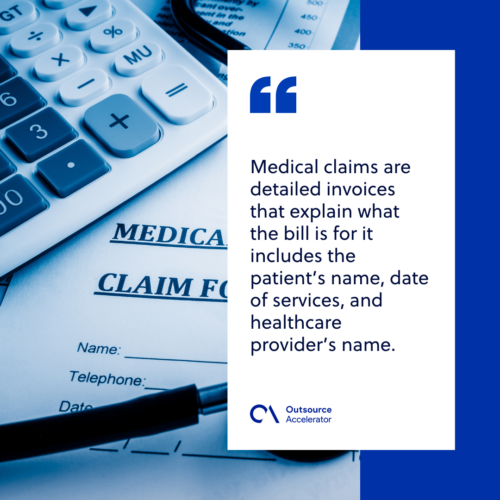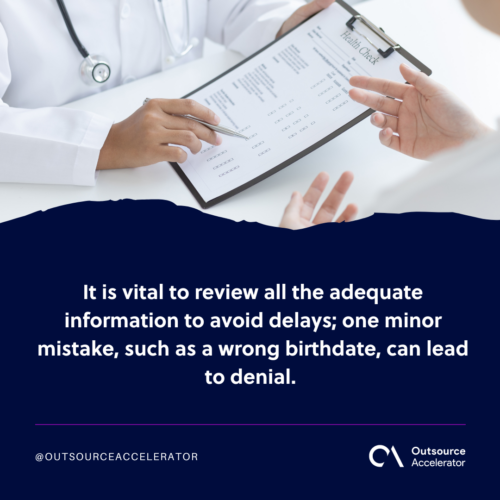Medical claim processing – a complete guide

Health service providers know that medical claim processing is tricky. They submit claims to get paid for their services. However, one of the challenges in a physician’s practice is claim denials.
According to AARP, one in seven claims gets rejected, which amounts to 200 million rejections yearly out of the 1.4 billion submitted. Healthcare providers rely on medical claims to get approved. But if it gets denied, they cannot collect revenue.
Before diving into the reasons for claim denials, it is crucial to learn the twists and turns of medical claims first.
What is a medical claim?
Health service providers request payment from the health insurance company after patient care. This invoice, which lists the services rendered, is called the medical claim.
Medical claims are detailed invoices that explain what the bill is for. Aside from the services rendered, the medical claim includes the patient’s name, date of services, and healthcare provider’s name.
Rejection in claims processing
Insurance companies process medical claims to assess whether the patient’s plan covers the service and determine the reimbursable cost. They may reject a claim request or reduce the payment to the provider.
There are several reasons for claim rejection. For instance, the company determined that the billed services were inappropriate for the diagnosis.
Thus, it is vital to review the claims to see if they are duplicated, forged, or invalid.

Steps in medical claim processing
When a healthcare provider submits medical claims, all the entered information and claim coverage must be verified. But how does the medical claims process work?
Here’s a step-by-step guide on how healthcare providers can secure medical claims:
Claim submission
More often than not, the doctors file the medical claims because they are most familiar with standardized medical codes and the overall claims processing endeavor.
They gather the relevant insurance information, fill out the codes, and send the claim to the claims processing department of the patient’s insurance company and involved healthcare providers.
This usually happens right after the doctor’s appointment, and the claims process begins after the doctor treats the patient.
Initial review
The claim will run through an algorithm that checks for illegible content, typos, inaccurate data, or duplicate charges.
If there are inaccuracies, such as common medical coding errors, the patient or the healthcare provider must re-submit the claim, or the insurance company may reject it.
This is why many health insurance companies and insurance providers are strict when people process claims and corresponding medical bills.
Moreover, the initial review ensures that the healthcare providers filed the claims within the filing period.
Eligibility assessment
The insurance company pays for medical claims if the patient’s plan covers the services.
Depending on the plan coverage and benefits, health insurance companies may pay for the entire cost or a portion. The patient is responsible for paying the remaining fee.
However, the claim is only accepted if the insurance provider covers the services rendered. The patient will pay for the entire cost in this case.
Repricing
By definition, claim repricing is the application of the contracted payment or the agreed-upon rates to any medical billing charges.
After the medical claims submission, the payer will look at the services rendered that the doctor disclosed in the claim. They will also apply the negotiated rate, the patient’s agreed-upon price to pay for the healthcare provider and facility.
Benefits adjudication
The insurance company decides the extent of its financial responsibility to the healthcare provider. This process is called claim adjudication.
Doing this will allow the insurance company to decide whether to pay in full, reduce the amount paid, or deny the claim.
Medical necessity review
During this step, the insurance company reviews if the patient’s plan covers the billed services listed in the claim. Basically, all relevant medical claims data are evaluated.
This part of the medical claims processing also checks if the services rendered are necessary or safe for the patient. This review will ensure that the patient does not pay for services that aren’t needed.

Risk review
Risk review tags a medical claim as “low-risk” or “high-risk” for insurance fraud. The tags will depend on the services rendered, individual line-item charges, and the total bill charge.
Payment
The insurance company calculates and pays the patient’s healthcare provider for reimbursement. This amount will be based on the agreed-upon rate and the patient’s benefits.
Explanation of benefits
The insurance company must provide an explanation of benefits (EOB) to show the insurance coverage breakdown. This statement means that the medical claims have been processed.
It should show how much they paid and the patient’s possible out-of-pocket expenses. But remember that EOB is not the bill. The patient must review the EOB thoroughly to ensure that it matches the services received.
Billing
When the payment is due, the healthcare provider’s office will send the patient the bill. It should match the amount and services listed on the EOB.
Best practices to streamline the claims process
Not all factors influencing claims processing are within one’s control. But there are ways to lessen the frustrations and confusion that come with medical claim processing.
Below are three essential best practices for successful medical claim processing:
Review all claims before submission
It is vital to review all the adequate information to avoid delays. This reduces the error rate and the risk of medical claims rejections in the long run.
One minor mistake, such as a wrong birthdate, can lead to denial.

Maintain billing and coding claims review log
There should be a log list to document the common reasons for claim denials. This can also be a handy reference to review the trends on the EOBs from each insurance provider and healthcare group.
Monitoring these trends can help find ways to address the reasons for claim rejections and delays in claims processing.
Provide a line-item billing statement
A line-item billing statement should show the patient’s total amount paid and outstanding charges. This allows the patient to review the statement clearly.
Understanding the basics of medical claims processing
Medical claims processing is much more than providing the right medical patient care. It is also about ensuring that insurance companies can pay healthcare providers.
The process might seem complicated. One way to make it more streamlined is by providing correct information before claim submission.
When claims are submitted accurately, everyone benefits.







 Independent
Independent




